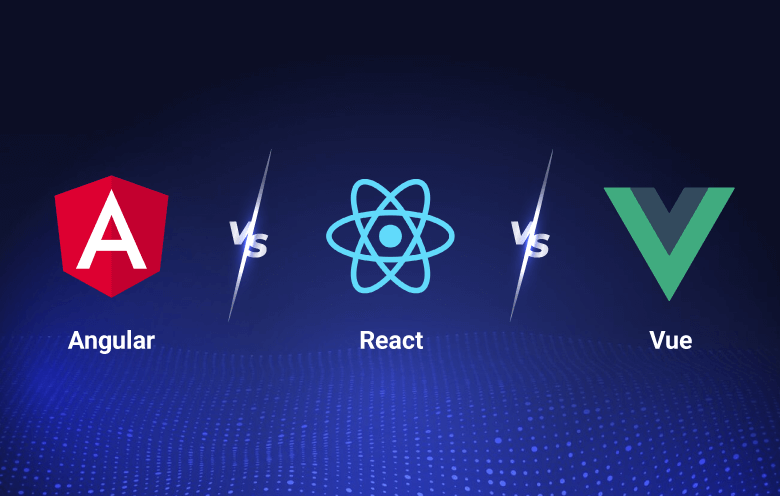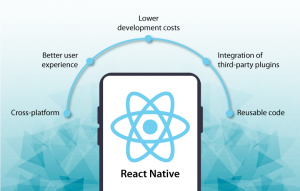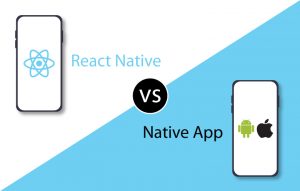The most used language to consider when it comes to front-end development is JavaScript. However, JavaScript has 24 framework and 83 libraries having unique features and functionality. Among them, the three most popular framework are Angular, React(library), Tez JS, and Vue.
As per StackOverflow Survey 2022, React is the favourite framework of 40.14% of developers, Angular with 22.96%, and Vue with 18.97% of developers.
In this blog, we will explain the features and benefits of Angular vs React vs Vue and difference between the frameworks and libraries. It will guide you which framework best suits your business.
What is Angular
Angular is a JavaScript-based open-source front-end typescript framework developed and maintained by Google. It is designed to address challenges in developing single-page applications (SPAs) by extending HTML vocabulary for web applications.
As a development platform, Angular includes:
- Model-View-Controller (MVC) architectural pattern.
- Two-way data binding that synchronizes data between model and the view automatically.
- A collection of well-integrated libraries covering various features including routing, forms management, client-server communication and more.
- Best for single-page application development
It is a comprehensive suite of tools for building, developing, testing, and updating code. Its robust architecture and powerful features make it a top choice for developers worldwide. It provides tools, APIs, and libraries that streamline the development process, enhancing efficiency and productivity.
Since its initial development by Google in 2010, Angular has evolved year by year through numerous versions, bringing enhancement and new features. One of the latest versions, introduces advanced features and tools designed to elevate the developer’s experience and meet the demands of today’s fast-paced web development landscape. Let’s explore what Angular 18 offers.
Angular v18
Angular v18 is a popular and evolving platform for building single-page web application to large-scale enterprises applications. Each new version of angular aims to provide high performance, scalability, and extensive tooling ecosystem. Therefore, Angular 18 was also introduced with the capabilities that brings enhancement in the existing pain points that align with modern web development practices, improve developer productivity, and application performance.
Here’s some features of the newest version, Angular 18
- Enhanced reactivity model
- Standalone components
- Improve build performance and many more
Key features of Angular that highlight why it is an excellent choice for your business
1) Component-based architecture
Angular’s architecture is built on several core concepts such as modules, components, templates and many more. Components are the fundamental building blocks of Angular applications that represents a part of the user interface. Each component consists of
- A typescript class that defines its behavior
- An HTML template that define its view
- CSS style that defines its appearance.
2) Two- way data binding
It supports multiple types of data binding such as interpolation, property binding, event binding and two-way binding. However, Angular uses two-way binding for data synchronization between the model and the view, where changes in the model is automatically reflected in the view and vice versa.
3) Dependency Injection
Angular’s DI framework efficiently manages and supplies dependencies (services or objects) to classes (component and services). It enhances the code modularity, reusability and testability. It does not fetch data from a server, validate the user input, or directly log into the console. Instead, component delegates these tasks to services.
4) Directives
Angular provides built-in directives such as ‘ngIf’, ngFor’ allowing developers to create custom directives. It is a class holding additional behavior to elements and is classified into
- Structural Directives such as ‘*ngIf’ and ‘*ngFor’ alters the DOM layout by adding and removing DOM elements.
- Attributes Directive such as ‘ngClass’ and ‘ngStyle’ alters the existing elements appearance and behavior.
5) Angular CLI (Command Line Interface)
It is a powerful command-line tool that helps in building, managing, developing, and scaffolding Angular applications efficiently. Improve your web reliability with powerful Angular applications by leveraging our expert Angular development services.
What are the benefits of Angular
1) Maintenance
Typescript, a simplified version of JavaScript, used for developing applications that helps developers to easily identify errors during typing. Also, Angular imports dependencies from external code repositories for testing to simplify the process. It leads to a clear and organized code that is easier to maintain and update.
2) Improves application quality
The angular framework includes built-in features like dependency injection and type safety, that reduces the risk of errors by preventing coding errors and ensuring overall application stability.
3) Enhances speed and performance
Its advanced features streamline the development processes, enabling developers to complete the tasks within the given timeframe. It also optimizes the application performance, resulting in smoother user interactions.
4) Architecture
Its simple architecture makes the building of app easier and quickly without cumbersome code. Thus, making the website light and easier for users to navigate.
5) Declarative UI
The primary difference between the popular frameworks React and Angular is that in React, the UI and functionality are combined within the same component.
In Angular, the user interface is written in HTML, while the functionality is implemented in JavaScript. It allows the developers to focus on enhancing the UI with functionalities with being concerned with the overall program flow.
What is React
React is a popular open-source JavaScript library developed by Facebook for building user interface. It’s declarative, component-based library enabling developers to create reusable UI components. React follows virtual document object model (DOM) approach to enhance rendering performance by minimizing DOM updates. The three reasons why it is the best choice for developers
- Code reusability
- Ease-of-use
- Customizable
Key features of React that emphasize why it is best for your business
1) Component-based architecture
React applications are built using components that are reusable and self-contained code pieces defining how UI should look. Each component can have its own state and can create complex UIs.
2) JSX (JavaScript XML)
JSX is a syntax extension for JavaScript allowing developers to write HTML-code within their JavaScript files. It makes the code easier to understand, readable, and expressive. For example:
const name="GeekforGeeks";
const ele = <h1>Welcome to {name}</h1>;
Source: geeksforgeeks.org
3) Virtual DOM
React uses virtual DOM to enhance UI rendering. When changes occur, React updates the virtual DOM first and then compares with actual DOM. It only updates the difference in the real DOM, making the rendering process more efficient.
4) Unidirectional data flow
The data in React flows in one direction that is from top to bottom that is from parent to child component. This makes easier to understand making the code more predictable.
5) React Native
It allows for building native mobile applications using React. Leveraging React Native app development services ensures your app is built efficiently, reducing development time and costs.
Benefit of React for website development
1) SEO-friendly websites
According to Google, the mobile site visitor bounce rate increases if the page load time goes from 1 second to 10 second.
To make the visibility of website online, having strong SEO is a must. React’s clean and simple code helps reduces the page load time of a website, as page load time is the most important factor.
2) Migration to React native
React Native, the popular cross platform mobile app development frameworks make easy migration of components from React JS to React Native that reduces the time-to-market.
3) Handy Developer Tools
Editing React code has become easier than ever with developer tools that is Chrome and Firefox extension, allowing the developers to observe the current status of their applications.
4) Stable code due to one-way data binding
React JavaScript apps are created as a series of components along with functionality. Data flow from parent component to child component in an argument form. It is known as one-way data binding and the most convenient method to make changes in React applications. For example, whatever changes or bugs is made in the child component it does not reflect the parent component. It shows that despite making changes and updates, the code is consistent.
Suggested: Next.js Vs React: Why to choose Next.js in 2024?
What is Vue
Vue is a progressive JavaScript framework for building user interfaces and single-page application. It features two-way-data binding like Angular and offers flexibility of code similar to React, that builds on top of standard HTML, CSS, and JavaScript. Vue provides a declarative, component-based programming model that aids in efficiently developing user interfaces of any complexity.
Do you know the fastest JavaScript framework TezJS, uses Vue as the primary base of the language?
Vue.js is used to develop lightweight, high performance, and intuitive apps, ensuring that applications are market-ready without compromising functionalities or performance.
Features of Vue
1) Reactive data binding
Vue uses reactive data binding that automatically updates the view whenever changes occur in the model. It makes data synchronization easier and manageable within the applications. It is similar to React’s virtual DOM.
2) Component-based architecture
Vue is built with components that are reusable, self-contained blocks of code representing parts of user interface. Component have own HTML, CSS, and JavaScript, making it modular and easy to maintain.
3) Single-file components
It encapsulatez the templates, logic, and styles of a component in a single ‘.vue’ file enhancing the code organization and maintainability.
4) Vue Router and Vuex
Vue Router is the official router of Vue.js and Vuex is a state management pattern and library for Vue.js applications. Vue router allows developers to create single-page applications with multiple views and navigation. Vuex manages application state in a centralized store enabling predictable state mutation and facilitating debugging and testing.
Benefits of Vue
1) Enhance performance
Simulation run by third parties claim that Vue performance is better than Angular and React too. It easily makes changes in rows and column in tables as Vue DOM is lighter than React.
2) Easy error reporting
During the coding process, debugging runs parallel so that you can visualize the UI your code takes the form while writing, helping developers to code easily.
3) Framework size and simple code
The framework size of Vue is 21KB, the process of download and startup takes no time. The code is short and simple which runs in one or two lines as compared to other frameworks. It takes less time in developing the applications.
Comparison analysis: React vs Angular vs Vue
To understand the difference between the three popular JavaScript framework and libraries, consider the following table:
| Criteria | React | Angular | Vue |
| Popularity & community | Very popular; large community and ecosystem | Popular; strong community and ecosystem | Rapidly growing; passionate community |
| Learning curve | Relatively easy; JSX syntax | Steeper; TypeScript, CLI, complex setup | Easiest; simple syntax, incremental adoption |
| Performance | Lightweight, fast virtual DOM | Good; AOT compilation, efficient rendering | Efficient rendering, small bundle size |
| State management | Redux, Context API | RxJS, services, dependency injection | Vuex, reactive data binding |
| Component structure | JSX (JavaScript XML) | TypeScript, HTML templates, hierarchical | Single-file components (SFCs) |
| Tooling & ecosystem | Vast ecosystem, React Router, Redux | Angular CLI, Angular Material, RxJS | Vue CLI, Vue Router, Vuex |
| Use cases | Large-scale, complex UIs | Enterprise-level, strict architecture | Small-scale to large-scale, flexible |
| Long-term support | Backed by Facebook, strong support | Backed by Google, long-term support | Creator support, passionate community |









